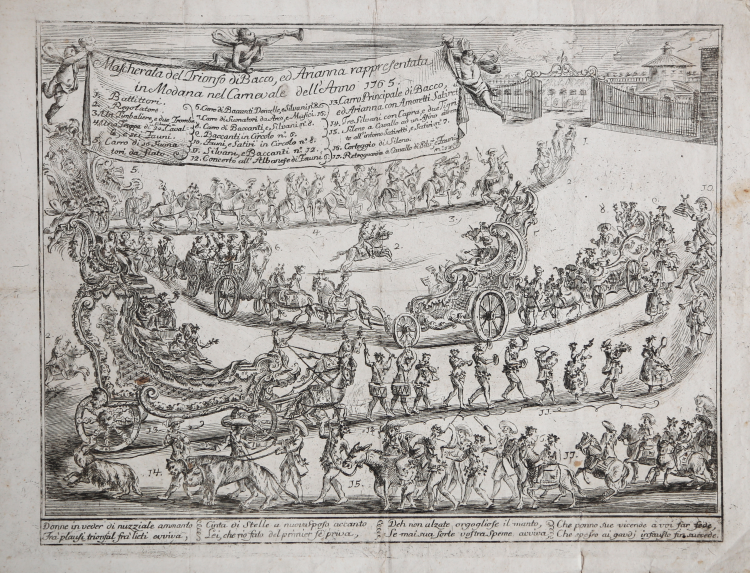




| Reference: | S46629 |
| Author | Carlo MANFREDI |
| Year: | 1765 |
| Measures: | 430 x 330 mm |



| Reference: | S46629 |
| Author | Carlo MANFREDI |
| Year: | 1765 |
| Measures: | 430 x 330 mm |
The title is followed by a 17-item legend, it is in the upper left-hand corner on a cloth supported by three angels; below, on four columns, an octave: "Donne in veder di nuzziale ammanto Frà plausi trionfal..." On the image 17 key-reference numbers.
The engraving is anonymous, but is described as a certain work of Carlo Manfredi by Angelo Davoli (1961, p. 82 n. 62).
At the Panizzi Library in Reggio Emilia there are 6 engravings by Carlo Manfredi (1703 - post 1783), depicting some "Masquerades" organized in the carnivals of 1741, 1742, 1750, 1762, 1765 and 1770, which add to the many pamphlets, volumes and flyleaves that report descriptions, songs and poetic compositions of the carnivals celebrated in Reggio in the 17th and 18th centuries.
Masquerades, which deal in a playful and licentious manner with the themes of love, trades, madness, the ages of man and social status, took on a more courtly, scenic and machinic character during the 17th century, parallel to what was happening within the Baroque theater. They are a form of aristocratic entertainment far removed from the magical propitiatory entertainment of popular rituals that also continued to take place in the city's back streets.
Beginning in 1720, then, the fact that Crown Prince Francesco Maria d'Este and his wife Carlotta Aglae d'Orléans had established their home in Reggio contributed to an increase in public entertainment opportunities, including carnival masquerades, to whose realization the Community now contributed more officially.
In the eighteenth-century masquerades the mischievous and amused spirit that had characterized those of the early seventeenth century returns. By this time, however, it is the expression of an academic and aristocratic class, which makes the tones more polite, especially when it takes its cue from popular culture: the allegorical themes are complex, the materials are precious, the pomp is sumptuous, and the machinery is artificial.
Masquerades of this kind, now tied so closely to Baroque culture and taste, begin to lose interest at the end of the 1700s, when they are replaced by the "Festa delle Vecchie," which had good fortune until the mid-19th century. In it, any citizen who applied to the Community of Reggio could grab a street or a square in which to erect a stage on which to perform ragdoll puppets in ridiculous skits relating to real-life city events and starring figures of old women.
Carlo Manfredi worked for a long time in Reggio Emilia as an engraver and chalcographer. The plates with the "Masquerades" are undoubtedly among his most successful works, which he produced on his own and printed to sell on festive occasions.
Etching, printed on contemporary laid paper, with margins, some paper creases and minor oxidation, otherwise in very good condition. Very rare work.
Bibliografia
Flavia de Lucis, Il carnevale e la festa delle vecchie, in: In forma di festa. Apparatori, decoratori, scenografi, impresari a Reggio Emilia dal 1600 al 1857, Casalecchio di Reno, Grafis Edizioni, 1985, pp. 125-147; Flavia de Lucis, La città come scena, in: Storia illustrata di Reggio Emilia. A cura di Maurizio Festanti e Giuseppe Gherpelli, coordinamento e ricerca iconografica di Laura Gasparini. Repubblica di San Marino, AIEP, 1987, vol. 3, p. 849-864; Zeno Davoli, Le incisioni classiche reggiane, Reggio Emilia, Tecnograf, 1978, n. 26; Zeno Davoli, La Raccolta di Stampe “Angelo Davoli”, Vol. Sesto M-Ne, Biblioteca Panizzi, Ganinetto delle stampe A. Davoli, pp. 63, n. 20244.
Carlo MANFREDI(Reggio Emilia 1703 - 1783 circa)
Carlo MANFREDI(Reggio Emilia 1703 - 1783 circa)